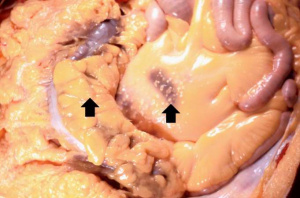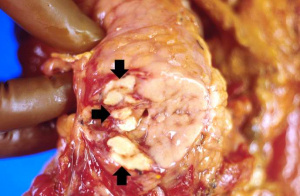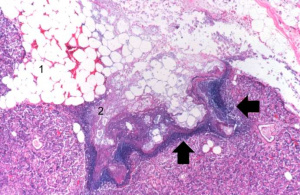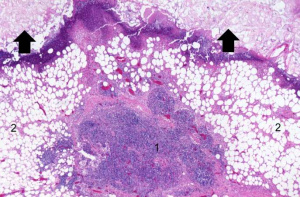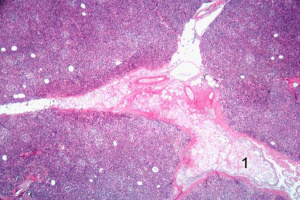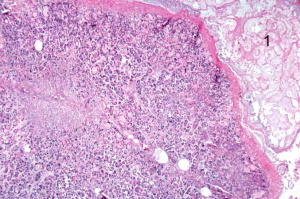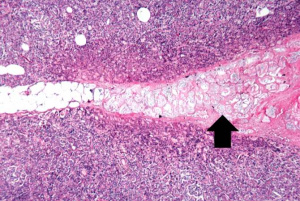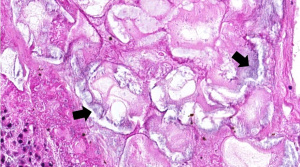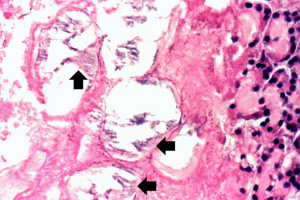Difference between revisions of "IPLab:Lab 1:Fat Necrosis"
Seung Park (talk | contribs) (Created page with "== Clinical Summary == This was a 37-year-old female with chronic renal failure that necessitated a renal transplant. Following transplantation, the patient developed a herpes...") |
Seung Park (talk | contribs) |
||
| Line 43: | Line 43: | ||
=== Reference === | === Reference === | ||
| − | * [http://emedicine.medscape.com/article/ | + | * [http://emedicine.medscape.com/article/775867-overview eMedicine Medical Library: Emergent Management of Pancreatitis] |
| − | * [http://www.merckmanuals.com/professional/ | + | * [http://www.merckmanuals.com/professional/gastrointestinal_disorders/pancreatitis/acute_pancreatitis.html Merck Manual: Acute Pancreatitis] |
=== Journal Articles === | === Journal Articles === | ||
| − | * | + | * Bhatnagar A, Wig J, Vaiphei K, Majumdar S. [http://www.ncbi.nlm.nih.gov/pubmed/11560386 Intracellular cytokines in cells of necrotic tissue from patients with acute pancreatitis]. ''Eur J Surg'' 2001 Jul;167(7):510-7. |
=== Images === | === Images === | ||
| − | * [http://peir.path.uab.edu/library/index.php?/tags/ | + | * [http://peir.path.uab.edu/library/index.php?/tags/333-pancreas PEIR Digital Library: Pancreas Images] |
| − | * [http://library.med.utah.edu/WebPath/ | + | * [http://library.med.utah.edu/WebPath/CINJHTML/CINJIDX.html WebPath: Cellular Injury Images] |
| − | |||
| − | |||
| − | |||
| − | |||
{{Template:IPLab 1}} | {{Template:IPLab 1}} | ||
[[Category:IPLab]] | [[Category:IPLab]] | ||
Revision as of 01:34, 16 August 2013
Contents
Clinical Summary[edit]
This was a 37-year-old female with chronic renal failure that necessitated a renal transplant. Following transplantation, the patient developed a herpes simplex virus (HSV) infection in her nasal cavity, oral candidiasis, pneumonia, hematuria, pyuria, and gastrointestinal bleeding. Subsequently, the patient became septic and died.
Autopsy Findings[edit]
Major findings at autopsy included extensive hemorrhagic bronchopneumonia (Pseudomonas aeruginosa) and multiple ulcers affecting the stomach and esophagus. There was also evidence of disseminated intravascular coagulation (DIC) with multiple hemorrhages present. Firm, whitish foci of necrotic tissue were found in the fat around the pancreas.
Images[edit]
Study Questions[edit]
Additional Resources[edit]
Reference[edit]
Journal Articles[edit]
- Bhatnagar A, Wig J, Vaiphei K, Majumdar S. Intracellular cytokines in cells of necrotic tissue from patients with acute pancreatitis. Eur J Surg 2001 Jul;167(7):510-7.
Images[edit]
| |||||
Renal failure is the severe reduction of renal function and often leads to reduced urinary output.
Candidiasis is an infection by the fungus Candida in the oral cavity.
In alcoholics, aspiration pneumonia is common--bacteria enter the lung via aspiration of gastric contents.
Hematuria is the presence of blood in the urine.
Pyuria is the presence of white blood cells (pus) in the urine.
Sepsis is the presence and persistence of pathogenic microorganisms and their toxins in the blood.
DIC is the development of small thrombi within the microcirculation throughout the body.
